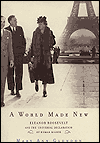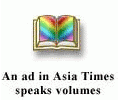| |
BOOK REVIEW
'Mrs R' and the human
rights scripture
A World Made New: Eleanor Roosevelt and
the Universal Declaration of Human Rights,
by Mary Ann Glendon
Reviewed by Sreeram Chaulia
 Legal
scholars have lionized the Universal Declaration of Human Rights
(UDHR) as the symbol, the representation, the pinnacle and the
scripture of the modern human rights movement. A humongous
amount of literature has been produced in the past 54 years on
the provisions, the debates and the significance of the UDHR in
international law, but the story of its genesis is usually
mentioned only in passing. Reticence on the historical creation
of the UDHR owes partly to unavailability of archival material
from the Eastern Bloc countries, and partly through the
inability of lawyers to escape the technical minutiae of clauses
and articles and write an account of the fascinating diplomacy
that accompanied its unveiling in 1947-48. Legal
scholars have lionized the Universal Declaration of Human Rights
(UDHR) as the symbol, the representation, the pinnacle and the
scripture of the modern human rights movement. A humongous
amount of literature has been produced in the past 54 years on
the provisions, the debates and the significance of the UDHR in
international law, but the story of its genesis is usually
mentioned only in passing. Reticence on the historical creation
of the UDHR owes partly to unavailability of archival material
from the Eastern Bloc countries, and partly through the
inability of lawyers to escape the technical minutiae of clauses
and articles and write an account of the fascinating diplomacy
that accompanied its unveiling in 1947-48.
Mary Ann Glendon, in spite of being a professor of law, has
filled the lacuna by writing a pulsating account with minimum
legalese, an effort putting professional historians to shame.
She researched personal correspondences of all major actors who
had a hand in the UDHR and also vetted sealed Soviet-era records
containing governmental positions and strategies in the
diplomatic roulette played out at the United Nations. The
capacity to bring alive characters of another age with vivid
flourish is rare in the legal profession, but Glendon has
succeeded beyond reproach in narrating the journey of an
extraordinary group of men and women who rose to the challenge
of a unique historical moment.
In 1943, US president Franklin D Roosevelt declared his vision
of a post-war peace saying, "The doctrine that the strong will
dominate the weak is the doctrine of our enemies - and we reject
it." His Wilsonian "four freedoms" concept aimed at amplifying
the voices of the weak in the corridors of power laid the
intellectual bedrock on which human rights were to be promoted
as a major issue in the newly constituted UN. At the Dumbarton
Oaks conference (1944), Britain and the USSR rejected American
proposals that human rights be listed as one of the UN's main
purposes, but allowed the subject to sneak in as a subsidiary
concern falling under the rubric of "economic and social
questions". The Nuremberg Principles of August 1945 left out the
issue of peacetime violations of human dignity, and the UN
Charter itself mentioned human rights as belonging to everyone
without enumerating or elaborating what the rights were. Glendon
terms human rights' fleeting appearance in the UN Charter "a
glimmering thread in a web of power and interest". (p.19)
Concerned with keeping the prestige of the Roosevelt name
associated with his administration, FDR's successor Harry Truman
named Eleanor Roosevelt US representative to the UN. It was a
momentous decision, because "Mrs R" was an accomplished
feminist, columnist and crusader against racism in her own right
and, as it turned out, also a great "people manager". She
recommended to the UN a permanent Commission on Human Rights for
drafting an "international bill of rights", inter alia because
the greatest cause of friction among nations was "lack of
standards for human rights".
At the first meeting of the commission at Lake Success in
January 1947, debate erupted among 16 member states on how the
proposed bill of rights could be implemented. Hansa Mehta of
India and Roy Hodgson of Australia favored establishing
international forums to hear complaints from victims of abuses,
as a bill would be "meaningless without some machinery for
enforcement". (p.38) Mrs Roosevelt, the US
delegate-cum-chairperson, parried the dilemma by practically
suggesting that implementation issues would be time-consuming
and should hence be taken up after the bill was completed.
Arguments on the antithesis between "individual" and "society"
also cropped up, foreshadowing trouble over the formulation of
economic and social rights.
A nucleus drafting committee, comprising Mrs Roosevelt, China's
P C Chang, Lebanon's Charles Malik and the UN secretariat's John
Humphrey, was set up to meet in June 1947 to prepare a
preliminary version of the bill. Humphrey's staff studied all
the world's existing constitutions and the torrent of
suggestions that poured into the UN from member states, private
organizations and interested individuals, such as H G Wells and
Mahatma Gandhi. It was a "distillation of nearly 200 years of
efforts to articulate the most basic human values in terms of
rights". (p.57) Rene Cassin, the French delegate, revised
Humphrey's draft and gave it internal logic and coherence by
introducing a preamble and conclusion, striking a balance
between the extremes of capitalist individualism and socialist
collectivism.
However, when the draft was submitted to the full commission,
the Soviet representative, Koretsky, reported to the Kremlin
that the main problem was that the bill "might make it easier to
intervene in the internal affairs of sovereign states". (p.71)
Implementation disputes broke out in full swing, with proposals
from Third World countries to convert the bill into a binding
convention or establishing an international tribunal to enforce
compliance of the bill, and the great powers shirking from any
legal commitment. Unable to break the logjam, Mrs Roosevelt
decided to proceed on three lines simultaneously - working on a
declaration, a legal covenant and measures of implementation.
She herself headed the declaration subcommittee, holding that
even a non-binding statement can greatly aid in securing
publicity for serious violations.
The implementation subcommittee ran into the doldrums soon, with
the USSR railing against "fantastic and dangerous international
controls" that infringed on a state's domestic jurisdiction. By
the end of 1947, unanimous approval of the declaration in the UN
General Assembly looked impossible as many states apprehended
its "potential for legitimating outside interference in a
country's internal affairs". (p.96) East-West tensions over
Berlin, China and Palestine were also beginning to cast an ugly
shadow over the commission's progress. Rapporteur Charles Malik
was weighed down by urgent responsibilities representing the
Arab League in the UN, and Chang withdrew into a shell as Mao
Zedong's armies approached Beijing, threatening his Kuomintang
government.
Pavlov, the Soviet delegate, made matters worse by proposing
that the Geneva draft of late 1947 be scrapped altogether and a
fresh one prepared. When the suggestion was voted down, he
engaged in skillful filibustering by proposing amendments to
almost every article in the draft, often on grounds that
"fascist and undemocratic elements" should not enjoy human
rights. He complained that the "new" economic and social rights
were being relegated to second tier by Western states bent on
allowing only their imperialist civil and political rights. As
the Cold War revved up, in the guise of rancor at the UN Human
Rights Commission, the Americans and Soviets were enacting a
face-off between central planning and free market economics. The
USSR and its allies abstained from the final vote in the
commission (June 1948), though the draft went through to the
next stage for consideration by the UN Economic and Social
Council (ECOSOC). At this juncture, the declaration was a
"fragile paper boat upon the troubled seas of world politics".
(p.121) More drama was to follow.
Fortuitously, Charles Malik was elected president of ECOSOC at
the time that the commission's draft declaration was tabled. His
diplomatic standing and persuasive skills came in handy against
a bunch of hard-nosed politicians in ECOSOC who were not
distinguished by their sympathy for human rights. Malik's
navigation sailed the draft through without amendments to the
next round of scrutiny before the UN General Assembly's Third
Committee on Social and Humanitarian Affairs. Given the
worsening state of East-West relations and a closing window of
opportunity for international agreement, "It was now or never
for the declaration." (p.132) US secretary of state George
Marshall gave a strong endorsement to the declaration and Mrs
Roosevelt also spoke widely inside and outside the UN to get the
draft passed.
Third committee members raised myriad objections that would
bedevil the declaration in the years to come. Saudi Arabia
claimed that articles relating to marriage and religious freedom
were based on "Western standards of family relations" and Pavlov
added that the document was disrespectful to national
sovereignty. Eastern Bloc members lambasted the declaration as
hypocritical, meaningless and patently false. Apartheid South
Africa questioned the phrasing of Article 1, opining that
"dignity" was not a "right". So vexed were smaller countries at
major power squabbling and utilization of the third committee
for slanging matches that the Mexican delegate protested in vain
how "countries of lesser importance were worried and helpless
spectators to verbal duels". (p.151) Mrs Roosevelt herself
opposed the article on social protection for the family since
the generic article on the right to a minimum standard of living
already covered it. In December 1948, the third committee
approved the draft for submission to the General Assembly, with
the Soviet Bloc abstaining again and contemplating announcement
of a rival draft.
In a last ditch effort to win over the USSR, Malik mentioned
each Russian delegate who had served on the commission by name
and praised them profusely before the General Assembly. Yet,
when the speeches rolled out from the Stalinist brigade, they
all condemned the declaration as "seriously defective". The
final tally of votes read: 48 in favor, eight abstentions and no
oppositions. Mrs Roosevelt attributed Russian obduracy mainly to
Article 13 (everyone has the right to leave his country), which
"they couldn't possibly accept" in the light of refugee and
defection games of the Cold War. In 1949, the trial of Hungarian
Cardinal Mindszenty and the plight of "Russian wives" received
wide publicity in the Western media as a violation of the UDHR
behind the Iron Curtain. In turn, communist states used sections
of the declaration in their tirades against racial
discrimination and economic injustice in America and Western
Europe. The intention of the framers had been that the
declaration would be considered holistically, but Cold War
wrangling reduced it to a document for choosing selectively in
propaganda warfare.
In the early 1950s, persecution of alleged "card-carrying
communists" and atomic scientists who were "fellow travellers"
turned America into an obstructionist force. Mrs Roosevelt
personally despised McCarthyism for using "methods of fear to
control all thought", but helplessly toed the State Department
line (and the British Foreign Office's brief) that the
unfinished covenant should be weak. Humphrey was so annoyed with
the change in someone he admired so much that he commented
bitterly, "Mrs R has become one of the most reactionary forces."
Rifts grew between the ex-first lady and other members of the
commission, culminating in her resignation in April 1951. Malik
succeeded as the new chairman of the commission, which by 1952
was paralyzed due to the by now full-fledged Cold War. "Power
politics was entering into and vitiating everything." (p.207)
The two covenants on civil and political rights, and economic,
social and cultural rights would not be finished until 1966,
with the US not ratifying the former until 1992, and never
ratifying the latter. Developing countries added a new layer of
problems to the human rights regime by questioning the
universality of the declaration in a multicultural world.
Glendon feels that "cultural diversity has been exaggerated" by
power-hungry and despotic Third World rulers on pretexts of
neo-colonialism, cultural imperialism, self-determination,
national sovereignty and economic development. It is often
forgotten that the declaration did not reflect one particular
philosophy, political system or people. What made it possible
were "similarity among all human beings" and the notion of a
single human experience irrespective of race, color, sex or
nationality.
The declaration inspired rights provisions in more than 90
constitutions during its lifetime and more than 140 countries
have signed the covenants. The declaration has retained a
special place in the minds of victims of abuse and those
fighting for their honor. As Mrs Roosevelt had envisaged, more
than the legally binding covenants, the simplicity and
syncretism of the "morally binding" declaration have been
appealed to whenever the question of human rights has arisen.
Glendon concludes with the apprehension that for Mrs Roosevelt
and her dedicated band, freedom and economic security were two
sides of the same coin, a notion that is being crushed today by
sundering the declaration into two halves and separating rights
to life, liberty and speech from global economic injustice.
People not yet born will pass judgment one day on whether we
enhanced or squandered the inheritance handed down to us by Mrs
Roosevelt, Malik, Chang, Cassin and Humphrey. The Cold War was a
lost age as far as human rights were concerned. It is now up to
the post-Cold War generation to pick up the pieces and remake
the world where all humans are free and equal in principle and
fact.
A World Made New. Eleanor Roosevelt and the Universal
Declaration of Human Rights, by Mary Ann Glendon, Random
House, 2001. ISBN: 0-375-76046-6. Price: US$15.95, 333 pages.
(©2002 Asia Times Online Co, Ltd. All rights reserved. Please
contact
[email protected] for
information on our sales and syndication policies.)
|
| |
|
|
 |
|




 Legal
scholars have lionized the Universal Declaration of Human Rights
(UDHR) as the symbol, the representation, the pinnacle and the
scripture of the modern human rights movement. A humongous
amount of literature has been produced in the past 54 years on
the provisions, the debates and the significance of the UDHR in
international law, but the story of its genesis is usually
mentioned only in passing. Reticence on the historical creation
of the UDHR owes partly to unavailability of archival material
from the Eastern Bloc countries, and partly through the
inability of lawyers to escape the technical minutiae of clauses
and articles and write an account of the fascinating diplomacy
that accompanied its unveiling in 1947-48.
Legal
scholars have lionized the Universal Declaration of Human Rights
(UDHR) as the symbol, the representation, the pinnacle and the
scripture of the modern human rights movement. A humongous
amount of literature has been produced in the past 54 years on
the provisions, the debates and the significance of the UDHR in
international law, but the story of its genesis is usually
mentioned only in passing. Reticence on the historical creation
of the UDHR owes partly to unavailability of archival material
from the Eastern Bloc countries, and partly through the
inability of lawyers to escape the technical minutiae of clauses
and articles and write an account of the fascinating diplomacy
that accompanied its unveiling in 1947-48. 










